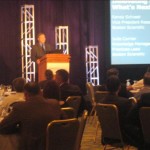Nov04
Lencioni: Arguing for Innovation
Point: Teams that create the best innovations know how to disagree about ideas without interpreting the disagreement as a personal affront.
Story: “I feel good when I see that engineering, advertising and manufacturing are really surfacing and talking about their differences,” said the VP of Technology at a successful $100 million firm. “It’s my job to keep the dialectic alive.”
When we see companies moving swiftly, anticipating changes in the marketplace and developing new products or services to meet the change, we’re tempted to think of the company as moving in harmonious agreement toward that new product or service.
But the surprising fact is that companies that innovate the fastest are actually those that invite debate over ideas. It’s not a destructive conflict, but an airing of different views on a topic. Whereas conflict based on personality differences is destructive, healthy conflict focuses on refining a proposed idea. Healthy conflict gets a team out of group-think. It tests and challenges assumptions. Team members share different points of view. As Patrick Lencioni, speaking at the 2009 World Business Forum said, “productive debate over issues is good for a team.” Disagreeing on issues make things uncomfortable but it builds clarity. “If you don’t have conflict on a team, you don’t get commitment,” Lencioni said. “If people don’t weigh in, they won’t buy in.” When team members challenge assumptions and point out the flaws of an idea, they improve the idea; the end result is a more robust idea.
destructive conflict, but an airing of different views on a topic. Whereas conflict based on personality differences is destructive, healthy conflict focuses on refining a proposed idea. Healthy conflict gets a team out of group-think. It tests and challenges assumptions. Team members share different points of view. As Patrick Lencioni, speaking at the 2009 World Business Forum said, “productive debate over issues is good for a team.” Disagreeing on issues make things uncomfortable but it builds clarity. “If you don’t have conflict on a team, you don’t get commitment,” Lencioni said. “If people don’t weigh in, they won’t buy in.” When team members challenge assumptions and point out the flaws of an idea, they improve the idea; the end result is a more robust idea.
To ensure that the conflict stays at the level of idea, not personal attack, Lencioni advises using a team assessment. Using an instrument like Myers-Briggs, team members learn their own communication styles and the styles of others. Knowing each other’s personality style helps avoid personal conflict. If you know that Joe is generally quiet or that Jane always bulldozes in, you’re less likely to take offense at what is actually that person’s communication style.
Action:
* Don’t suppress or circumvent conflict – the best ideas are forged during the “working out” of such conflicts.
* Give the team an assessment tool like Myers-Briggs to help member understand each other’s styles communication styles, strengths and weaknesses
* Encourage healthy debate. Peter Drucker recounted how Alfred P. Sloan, legendary CEO of GM, handled this:
“Gentlemen, I take it we are all in complete agreement on the decision here,” Sloan said. After everyone around the table nodded affirmatively, Sloan continued: “Then I propose we postpone further discussion of this matter until our next meeting to give ourselves time to develop disagreement and perhaps gain some understanding of what the decision is all about.”










